
Architecture of Singapore
Encyclopedia

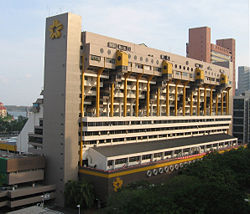
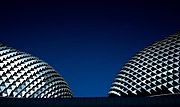
Architecture
Architecture is both the process and product of planning, designing and construction. Architectural works, in the material form of buildings, are often perceived as cultural and political symbols and as works of art...
of Singapore
Singapore
Singapore , officially the Republic of Singapore, is a Southeast Asian city-state off the southern tip of the Malay Peninsula, north of the equator. An island country made up of 63 islands, it is separated from Malaysia by the Straits of Johor to its north and from Indonesia's Riau Islands by the...
displays a range of influences and styles from different places and periods. These range from the eclectic styles and hybrid forms of the colonial period to the tendency of more contemporary architecture to incorporate trends from around the world. In both aesthetic and technological terms, Singapore architecture may be divided into the more traditional pre-World War II
World War II
World War II, or the Second World War , was a global conflict lasting from 1939 to 1945, involving most of the world's nations—including all of the great powers—eventually forming two opposing military alliances: the Allies and the Axis...
colonial period, and the largely modern post-war and post-colonial period.
Traditional architecture in Singapore includes vernacular Malay houses
Malay houses
Malay houses are traditional dwellings, originating before the arrival of foreign or modern influences, and constructed by the indigenous ethnic Malay and Orang Asli peoples of the Malay Peninsula and their related Bumiputra tribes of East Malaysia....
, local hybrid shophouse
Shophouse
A shophouse is a vernacular architectural building type that is commonly seen in areas such as urban Southeast Asia. This hybrid building form characterises the historical centres of most towns and cities in the region.- Design and features :...
s and black and white bungalow
Black and white bungalow
A black and white bungalow is a white-painted bungalow of a style once commonly used to house European expatriate or colonial families in tropical colonies, typically the Southeast Asian colonies of the British Empire in the nineteenth century....
s, a range of places of worship reflecting the ethnic and religious diversity of the city-state as well as colonial civic and commercial architecture in European Neoclassical
Neoclassical architecture
Neoclassical architecture was an architectural style produced by the neoclassical movement that began in the mid-18th century, manifested both in its details as a reaction against the Rococo style of naturalistic ornament, and in its architectural formulas as an outgrowth of some classicizing...
, gothic
Gothic architecture
Gothic architecture is a style of architecture that flourished during the high and late medieval period. It evolved from Romanesque architecture and was succeeded by Renaissance architecture....
, palladian and renaissance
Renaissance
The Renaissance was a cultural movement that spanned roughly the 14th to the 17th century, beginning in Italy in the Late Middle Ages and later spreading to the rest of Europe. The term is also used more loosely to refer to the historical era, but since the changes of the Renaissance were not...
styles.
Modern architecture in Singapore began with the transitional Art Deco
Art Deco
Art deco , or deco, is an eclectic artistic and design style that began in Paris in the 1920s and flourished internationally throughout the 1930s, into the World War II era. The style influenced all areas of design, including architecture and interior design, industrial design, fashion and...
style and the arrival of reinforced concrete
Reinforced concrete
Reinforced concrete is concrete in which reinforcement bars , reinforcement grids, plates or fibers have been incorporated to strengthen the concrete in tension. It was invented by French gardener Joseph Monier in 1849 and patented in 1867. The term Ferro Concrete refers only to concrete that is...
as a popular building material. International Style
International style (architecture)
The International style is a major architectural style that emerged in the 1920s and 1930s, the formative decades of Modern architecture. The term originated from the name of a book by Henry-Russell Hitchcock and Philip Johnson, The International Style...
modern architecture was popular from the 1950s to the 1970s, especially in the public housing apartment blocks. The Brutalist style of architecture was also popular in the 1970s. These styles coincided with the great urban renewal and building boom periods in Singapore history, and consequently these are the most common architectural styles seen on the island. Some of the more architecturally significant works of this period include Pearl Bank Apartments
Pearl Bank Apartments
Pearl Bank Apartments is a high-rise private residential building on Pearl's Hill in Outram, near the Chinatown of Singapore.As the tallest and densest residential building in Singapore when completed in 1976, Pearl Bank Apartments was one of Singapore's pioneers of high-rise, high-density living,...
by Tan Cheng Siong, and the People's Park Complex
People's Park Complex
People's Park Complex is a high-rise commercial and residential building on Eu Tong Sen Street in Outram, within the Chinatown of Singapore.-History:...
and Golden Mile Complex
Golden Mile Complex
Golden Mile Complex is a high-rise commercial and residential building on Beach Road in Kallang, Singapore. The building was formerly known as Woh Hup Complex...
by Design Partnership.
Post-modern architecture experiments, in both the 'historicist' and deconstructivist modes made an appearance in the 1980s, though the style was relatively muted in its expression. Another architectural trend has been the rediscovery of Singapore's architectural heritage, leading to an active conservation programme as well as a booming industry in the restoration of historic buildings, often adapting them to new uses. A recent example is the National Museum of Singapore
National Museum of Singapore
The National Museum of Singapore is a national museum in Singapore and the oldest museum in Singapore. Its history dates back to 1849 when it was started as a section of a library at Singapore Institution...
.
An important area of local innovation has involved seeking to develop a form of modern architecture appropriate to Singapore's tropical climate. This climatically sensitive approach to architecture traces its roots back to the vernacular Malay houses and through to experiments by British colonial architects and early local nationalist architects to devise an authentically local architecture using modern construction methods. In the 1980s and especially from the late 1990s, this has led to a proliferation of what might be called 'modern tropical' architecture, or neo-tropical architecture. It involves a return to clean and simple rectilinear modernist forms, coupled with an emphasis of lush landscaping and sleek sun-shading in the form of metal or wood louvres, instead of the modernist glass
Glass
Glass is an amorphous solid material. Glasses are typically brittle and optically transparent.The most familiar type of glass, used for centuries in windows and drinking vessels, is soda-lime glass, composed of about 75% silica plus Na2O, CaO, and several minor additives...
curtain wall
Curtain wall
A curtain wall is an outer covering of a building in which the outer walls are non-structural, but merely keep out the weather. As the curtain wall is non-structural it can be made of a lightweight material reducing construction costs. When glass is used as the curtain wall, a great advantage is...
, which admits and traps solar heat. These architectural efforts have taken on a new relevance and urgency due to concerns about global warming
Global warming
Global warming refers to the rising average temperature of Earth's atmosphere and oceans and its projected continuation. In the last 100 years, Earth's average surface temperature increased by about with about two thirds of the increase occurring over just the last three decades...
, climate change
Climate change
Climate change is a significant and lasting change in the statistical distribution of weather patterns over periods ranging from decades to millions of years. It may be a change in average weather conditions or the distribution of events around that average...
and environmental sustainability
Sustainability
Sustainability is the capacity to endure. For humans, sustainability is the long-term maintenance of well being, which has environmental, economic, and social dimensions, and encompasses the concept of union, an interdependent relationship and mutual responsible position with all living and non...
, especially given that air conditioning
Air conditioning
An air conditioner is a home appliance, system, or mechanism designed to dehumidify and extract heat from an area. The cooling is done using a simple refrigeration cycle...
in buildings is one of the largest consumers of electricity in Singapore, which is mostly generated by fossil fuels.
From the late 1990s, like many other global cities and aspiring global cities, the Singapore government consciously launched a drive to develop 'iconic' landmarks in the city, as a means to strengthening the Singapore brand identity as well as to attract foreign tourists, skilled immigrants, investements and buzz. Several such landmark projects have since been developed, sometimes through open or closed architectural design competition
Architectural design competition
An architectural design competition is a special type of competition in which an organization or government body that plans to build a new building asks for architects to submit a proposed design for a building. The winning design is usually chosen by an independent panel of design professionals...
s. These include the Esplanade - Theatres on the Bay
Esplanade - Theatres on the Bay
Esplanade – Theatres on the Bay is a waterside building located on six hectares of waterfront land alongside Marina Bay near the mouth of the Singapore River, purpose-built to be the centre for performing arts for the island nation of Singapore...
arts centre, the Supreme Court of Singapore, the new National Library, Singapore
National Library, Singapore
The National Library in Singapore is located on an 11,304-square metre site between Bugis Junction and the Bras Basah Complex at 100, Victoria Street...
, the Marina Bay Sands Integrated Resort and the Singapore Flyer
Singapore Flyer
The Singapore Flyer is a giant Ferris wheel located in Singapore, constructed in 2005–2008. Described by its operators as an observation wheel, it reaches 42 stories high, with a total height of , making it the tallest Ferris wheel in the world, taller than the Star of Nanchang and taller than...
.
Pre-colonial architecture
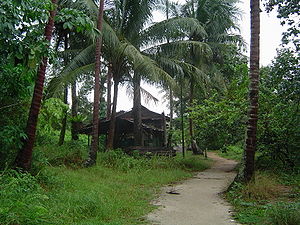
Prior to the British establishment of a settlement in 1819, architecture followed the pattern of the surrounding region. Vernacular architecture comprised village (or 'kampong') houses built in the Malay tradition. Malay kampong houses were built on stilts and raised above the ground (or water, depending on their location). The house was erected around a skeletal structure of tropical hardwood posts and beams, usually cengai. Medium hardwoods, like meranti, were used as floor boards, roof rafters and door and window frames. The roof itself was made of layers of palm frond thatch, while the walls were either made of woven bamboo strips or meranti planks. The basic form of the house was simple, but additional rooms could be added according to the requirements and wealth of the family. Likewise, the architectural ornament, in the form of carved wood fascia boards, screens and panels, could be quite elaborate.
Apart from this domestic rural architecture, there is evidence that more classical type buildings may have been built on the island. A nearby example of similar classical Hindu-Buddhist Malay architecture is Candi Muara Takus
Candi Muara Takus
Muara Takus is a Buddhist temple complex, thought to belong to the Sriwijaya empire. It is situated in Kampar Regency in Riau province, Sumatra, Indonesia. Its surviving temples and other archaeological remains are thought to date to the eleventh and twelfth century AD...
in the Riau province of Sumatra
Sumatra
Sumatra is an island in western Indonesia, westernmost of the Sunda Islands. It is the largest island entirely in Indonesia , and the sixth largest island in the world at 473,481 km2 with a population of 50,365,538...
. Like the Singapore example, it also featured the use of sandstone as well as terraces. Stone foundations on Fort Canning Hill were discovered by the British soon after they arrived. Although they have since been destroyed and removed, the officials who discovered them speculated they were part of Hindu or Buddhist temples and/or a royal palace. The superstructure
Superstructure
A superstructure is an upward extension of an existing structure above a baseline. This term is applied to various kinds of physical structures such as buildings, bridges, or ships...
of these buildings would have been timber (as suggested by holes found in the foundations). However, these had long since disappeared by the time the foundations were discovered in 1819. Apart from some archaeological fragments, like jewellery, porcelain, coins and an inscribed stone, there few material artifacts from the pre-colonial period, and no buildings or even ruins remaining today.
Colonial period

Singapore River
The Singapore River is a river in Singapore with great historical importance. The Singapore River flows from the Central Area, which lies in the Central Region in the southern part of Singapore before emptying into the ocean...
in 1819, changes came to way the buildings were constructed in Singapore. Despite its small initial size, the new settlement had decidedly urban
Urban area
An urban area is characterized by higher population density and vast human features in comparison to areas surrounding it. Urban areas may be cities, towns or conurbations, but the term is not commonly extended to rural settlements such as villages and hamlets.Urban areas are created and further...
characteristics and ambitions. Merchants built their warehouses right next to each other along Boat Quay
Boat Quay
Boat Quay is a historical quay in Singapore which is situated upstream from the mouth of the Singapore River on its southern bank.It was the busiest part of the old Port of Singapore, handling three quarters of all shipping business during the 1860s...
, which was the main port area. However, the close proximity of these buildings as well as the value of the goods stored within them, raised concerns about the threat of fire, especially given the flammable nature of the traditional building materials (timber floors and walls with thatch roofs). Consequently, a switch was made within the first decade to build all urban buildings in brick masonry
Masonry
Masonry is the building of structures from individual units laid in and bound together by mortar; the term masonry can also refer to the units themselves. The common materials of masonry construction are brick, stone, marble, granite, travertine, limestone; concrete block, glass block, stucco, and...
with clay tiled roofs, to reduce the fire hazard. Bricks and tiles were manufactured at kilns on the island, while the mortar and plaster used was made by grinding up corals from sea around Singapore.
In the 19th century, two hybrid
Cross-genre
A cross-genre is a genre in fiction that blends themes and elements from two or more different genres.-Examples:*Action comedy *Comedy-drama or dramedy *Comedy-horror...
building typologies evolved in Singapore. While their origins can be traced elsewhere, these building types underwent significant local adaptation and modification before spreading regionally. As a result, they are Singapore's earliest known architectural innovations and exports. These hybrid building typologies were the shophouse and the black and white bungalow.
Shophouse
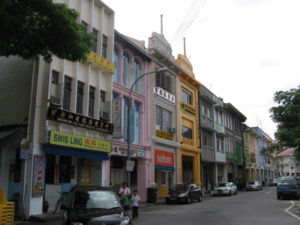
Traditional places of worship
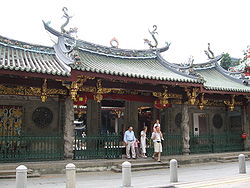
Apart from being devoted to the various schisms and sects within each religious tradition, these buildings were often built to serve ethnic groups and sub-groups. For examples, while most Muslims in Singapore were and are Malay, some mosques were built in the South Indian style to serve Tamil Muslims. Likewise, several churches were built in a distinctly Chinese style, serving ethnic Chinese congregations.
Several of the oldest and most important places of worship in Singapore have been designated National Monuments of Singapore
National Monuments of Singapore
National Monuments of Singapore are buildings and structures in Singapore that have been designated by the Preservation of Monuments Board as being of special historic, traditional, archaeological, architectural or artistic value....
, and they include the Armenian Church
Armenian Church, Singapore
The Armenian Church is the oldest Christian church in Singapore, located at Hill Street in the Museum Planning Area, within the Central Area, Singapore's central business district.-History:George Drumgoole Coleman, overseer of Convicts and Superintendent of Public Works, was the architect of many of...
, Thian Hock Keng Temple, Sultan Mosque, Sri Mariamman Temple, Jamae Mosque and Telok Ayer Chinese Methodist Church
Telok Ayer Chinese Methodist Church
Telok Ayer Chinese Methodist Church is a Chinese Annual Conference Methodist church located in the Asian nation-city of Singapore. The church is found at two locations, one that is located along Telok Ayer Street near Chinatown in the Downtown Core, in Singapore's central business district and...
, amongst others.
Colonial civic buildings
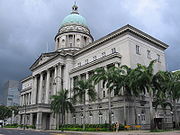
Renaissance
The Renaissance was a cultural movement that spanned roughly the 14th to the 17th century, beginning in Italy in the Late Middle Ages and later spreading to the rest of Europe. The term is also used more loosely to refer to the historical era, but since the changes of the Renaissance were not...
, or Neoclassical
Neoclassical architecture
Neoclassical architecture was an architectural style produced by the neoclassical movement that began in the mid-18th century, manifested both in its details as a reaction against the Rococo style of naturalistic ornament, and in its architectural formulas as an outgrowth of some classicizing...
styles. Some of the more important buildings included the Victoria Theatre and Concert Hall
Victoria Theatre and Concert Hall
The Victoria Theatre and Concert Hall is a complex of two buildings and a clock tower joined together by a common corridor and is located in the civic district of Singapore...
, the Fullerton Building, old Supreme Court Building
Old Supreme Court Building
The Old Supreme Court Building is the former courthouse of the Supreme Court of Singapore, before it moved out of the building and commenced operations in the new building on 20 June 2005...
, City Hall, Singapore
City Hall, Singapore
The City Hall in Singapore is a national monument gazetted on 14 February 1992. Located in front of the historical Padang and next door to the Supreme Court of Singapore, it was designed and built by the architects of the municipal government, A. Gordans and F. D. Meadows from 1926 to 1929...
, National Museum of Singapore
National Museum of Singapore
The National Museum of Singapore is a national museum in Singapore and the oldest museum in Singapore. Its history dates back to 1849 when it was started as a section of a library at Singapore Institution...
, old Hill Street Police Station, Central Fire Station, old Raffles Institution
Raffles Institution
Raffles Institution , founded in 1823, is the oldest centre for pre-tertiary learning in Singapore. It is an independent school in Singapore providing secondary and pre-university education. RI consists of a boys-only secondary section , and a coeducational pre-university section...
buildings, Changi Prison
Changi Prison
Changi Prison is a prison located in Changi in the eastern part of Singapore.-First prison and POW camp:...
, old NCO club and numerous other schools, post offices, military camps and police stations around the island.
Major commercial buildings, often erected by European businesses as well as mission schools and other civic groups, also adopted these styles, such as the Raffles Hotel
Raffles Hotel
Raffles Hotel is a colonial-style hotel in Singapore, and one of the world's most famous hotels. The hotel was established by the famous Armenian Sarkies Brothers. Opened in 1887, it was named after Singapore's founder Sir Stamford Raffles. Managed by Fairmont Raffles Hotels International, it is...
, Convent of the Holy Infant Jesus (now CHIJMES
CHIJMES
CHIJMES is a historic building complex in Singapore, which began life as a Catholic convent known as the Convent of the Holy Infant Jesus and convent quarters known as Caldwell House...
), old St Joseph's Institution and old Tao Nan School. Often the approach to matters of style was highly eclectic, and builders combined a variety of stylistic elements from various European, and some non-European, sources in the same building. Many colonial-era buildings are still found in the city, as a result of aggressive conservation
Architectural conservation
Architectural conservation describes the process through which the material, historical, and design integrity of mankind's built heritage are prolonged through carefully planned interventions. The individual engaged in this pursuit is known as an architectural conservator...
efforts of Singapore's built heritage since the 1980s.
Art Deco architecture
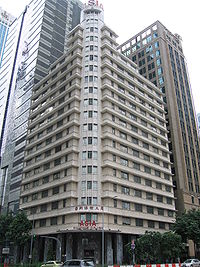
Art Deco
Art deco , or deco, is an eclectic artistic and design style that began in Paris in the 1920s and flourished internationally throughout the 1930s, into the World War II era. The style influenced all areas of design, including architecture and interior design, industrial design, fashion and...
architecture, dating mainly from the 1920s and 1930s. The style was especially popular in commercial architecture, like factories and offices. Often, Art Deco style ornaments and elements were applied onto otherwise typical shophouses or bungalows. In other cases, Art Deco was applied to newly emergent types of buildings, like Kallang Airport
Kallang Airport
The Kallang Airport , also known as the Kallang Aerodrome, Kallang Airfield and RAF Kallang, opened in 1937 as Singapore's first purpose-built civil airport, together with an anchorage for seaplanes. Land was reclaimed in the Kallang Basin to turn the swampy area into a circular-shaped airfield and...
(by the Public Works Department), the Ford Factory (by Emile Brizay) or Singapore's first skyscraper
Skyscraper
A skyscraper is a tall, continuously habitable building of many stories, often designed for office and commercial use. There is no official definition or height above which a building may be classified as a skyscraper...
s, the Cathay Building
Cathay Building
The Cathay Building was opened in 1939 by Dato Loke Wan Tho as the headquarters for the British Malaya Broadcasting Corporation...
(by Frank Brewer) and the Asia Insurance Building
Asia Insurance Building
The former Asia Insurance Building is a high-rise building formerly for commercial use, located on Finlayson Green near Raffles Place, in Singapore's Downtown Core. The Asia Insurance Building was also known as the A.I...
(by Ng Keng Siang). Features of this style in the local context included a penchant for inscribing the date of the erection of the building prominently on its facade, the use of projecting horizontal fins as sun shading devices over windows and the use of flagpoles. Quite apart from the aesthetics of this style, the Art Deco period also marked the introduction of modern construction technologies like reinforced concrete in Singapore.
Modern architecture
Following the Neoclassical and Art Deco phases, Singaporean architecture moved in a decidedly modern direction after the war. Post-war austerity encouraged the use of clean, stark and simple modernist forms and surfaces devoid of ornament. Modern architecture was also preferred for the many 'cookie-cutter' or standardised design public buildings being built at the time, such as schools, clinics, factories and especially public housing.Public housing
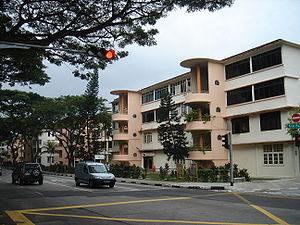
Singapore Improvement Trust
-History:The Singapore Improvement Trust was a government organisation set up in 1927 by the British colonial government in Singapore in response to the housing needs of the population of Singapore. At that time, many people resided in overcrowded shophouses and squatter settlements, resulting in...
(SIT), a colonial government agency, embarked on a building programme to address a shortage of affordable housing in Singapore. Initially, the SIT focussed on housing middle and lower-middle class Asians. The most prominent example of their pre-war efforts was the Tiong Bahru estate, where many low-rise, four-storey Art Deco style apartment blocks, shops, markets and other amenities were built on the city fringe. This programme continued after the war, with the Art Deco style exchanged for a simple modern aesthetic. Although the estate was popular and praised for spacious and green communal areas as well as attractively designed blocks, the rate of construction was slow in relation to the scale of the housing shortage in Singapore.
After the People's Action Party
People's Action Party
The People's Action Party is the leading political party in Singapore. It has been the city-state's ruling political party since 1959....
came to power in 1959, it embarked on a massive public housing programme, which was one of its signature campaign promises. It replaced the SIT with the Housing and Development Board (HDB). The HDB was given the legal tools and financial resources needed to make great progress in speeding up the building of public housing. Architecturally, this resulted in a relatively homogenous suburban landscape, where satellite new town
New town
A new town is a specific type of a planned community, or planned city, that was carefully planned from its inception and is typically constructed in a previously undeveloped area. This contrasts with settlements that evolve in a more ad hoc fashion. Land use conflicts are uncommon in new...
s (modelled after the British), were built with seemingly endless stacks of slab blocks housing tens of thousands of peoples in small two and three bedroom flats.
1970s to present
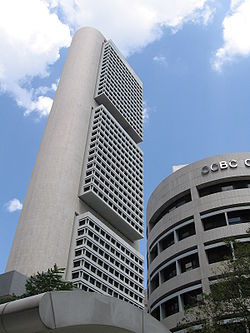
Modern architecture
Modern architecture is generally characterized by simplification of form and creation of ornament from the structure and theme of the building. It is a term applied to an overarching movement, with its exact definition and scope varying widely...
, particularly the brutalist style
Brutalist architecture
Brutalist architecture is a style of architecture which flourished from the 1950s to the mid 1970s, spawned from the modernist architectural movement.-The term "brutalism":...
. This is seen in some of the older commercial buildings, such as the OCBC Centre
OCBC Centre
OCBC Centre is a , 52-storey skyscraper in Singapore. serving as the current headquarters of OCBC Bank, the building was completed in 1976 and was the tallest building in the country, and South East Asia, at that time. There are two extensions, OCBC Centre South and OCBC Centre East. There is an...
by I. M. Pei
I. M. Pei
Ieoh Ming Pei , commonly known as I. M. Pei, is a Chinese American architect, often called a master of modern architecture. Born in Canton, China and raised in Hong Kong and Shanghai, Pei drew inspiration at an early age from the gardens at Suzhou...
, as well as many buildings built to house governmental offices and government-linked companies, including the Singapore Land Tower
Singapore Land Tower
Singapore Land Tower is a high-rise skyscraper located in the central business district of Singapore. It is located on 50 Raffles Place, next to Raffles Place MRT Station. It is just 100 metres away from Boat Quay and Collyer Quay....
, Temasek Tower
Temasek Tower
8 Shenton Way , formerly The Treasury and Temasek Tower, is the sixth tallest skyscraper in the city of Singapore, with at . It is currently the tallest cylindrical building in the world. Built in 1986 as Treasury Building, it has 52 stories and is one of the prominent buildings in the business...
, DBS Building, and the CPF Building
CPF Building
The CPF Building is a high-rise skyscraper located in the central business district of Singapore. It is located on 79 Robinson Road, in the Shenton Way and Tanjong Pagar zone. The building is near several other skyscrapers such as DBS Building Tower One, SIA Building and Capital Tower, which are...
. Changing international architectural trends introduced some architectural styles (particularly the postmodernist
Postmodern architecture
Postmodern architecture began as an international style the first examples of which are generally cited as being from the 1950s, but did not become a movement until the late 1970s and continues to influence present-day architecture...
style) here.
See also
- ShophouseShophouseA shophouse is a vernacular architectural building type that is commonly seen in areas such as urban Southeast Asia. This hybrid building form characterises the historical centres of most towns and cities in the region.- Design and features :...
- Black and white bungalowBlack and white bungalowA black and white bungalow is a white-painted bungalow of a style once commonly used to house European expatriate or colonial families in tropical colonies, typically the Southeast Asian colonies of the British Empire in the nineteenth century....
- National Monuments of SingaporeNational Monuments of SingaporeNational Monuments of Singapore are buildings and structures in Singapore that have been designated by the Preservation of Monuments Board as being of special historic, traditional, archaeological, architectural or artistic value....
- Public housing in SingaporePublic housing in SingaporePublic housing in Singapore is currently managed by the Housing and Development Board. The majority of the residential housing developments in Singapore are publicly governed and developed and about 85% of Singaporeans live in such houses...
- [

